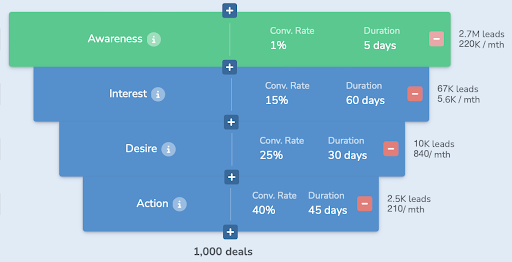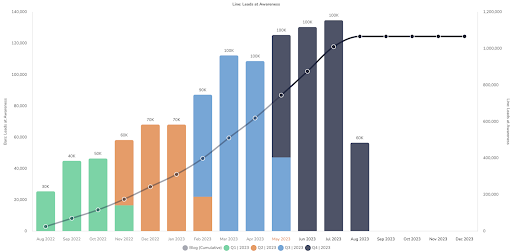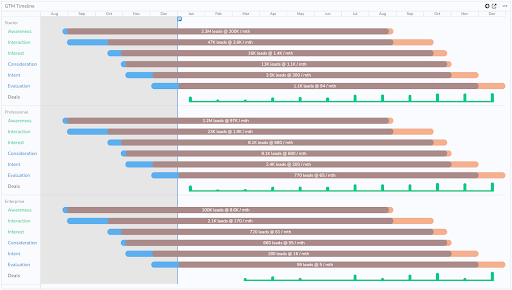The Weakness & Strength of Inherent Optimism
Sales is the lifeblood of any business and realistic planning is the key to an accurate forecast. Given its importance, why do we struggle to predict...
Revenue planning is an important strategy to ensure successful sales and marketing initiatives. Through this bottom-up revenue planning process, organizations use a just-in-time manufacturing style approach.
Determining how many sales and how much associated revenue you will generate based on what you know about your business and market can be a bit of a crapshoot.
That is because there are so many influences that impact the revenue outcome of your go-to-market strategy. Worse, these influences drive more and more uncertainty over time—the longer your forecast, the wider the range of possible outcomes.
As a business founder, I was for many years ultimately responsible for both setting a revenue target and subsequently hitting that target. However, I mistakenly treated these as two different problems that had to be solved independently rather than treating them as a combined objective.
At the beginning of the year, I would set an annual goal based on influences such as prior year performance, upcoming product releases, the current momentum of the business, and so forth. I would use my inherent knowledge of the business to determine our goal. From there, the company would then march towards hitting that goal—plain and simple. While we were highly focused and dedicated, our march was in many ways a brute force charge; ironically for a company that prided itself in using analytics to help solve forecasting challenges in the construction industry, we were terrible at forecasting our own destiny as a business!
The net result was a high-risk, low-probability-of-success revenue plan that most often resulted in us missing our number. While our achieved performance may have actually been good, we set an unrealistic goal that made it be perceived as insufficient. We set ourselves up for failure because we didn’t revenue plan appropriately in the first place.
With hindsight, we should have adopted a smarter approach that carried an aligned goal and plan. An approach that should have started with a desired end goal (e.g., “2023 revenue target of $10 million”) and then—more importantly—a plan to support it.
With such insight, even if our plan was too ambitious, we could have dialed back and adjusted our aspirations. Or better still, we could have adjusted our goal upward if our model suggested we could do better! Either way, linking our plan with our goal was something we missed the mark on and yet was so key—the basis of what today we call bottom-up or goal-seek planning.
Adopting a bottom-up approach to calculating required marketing and sales activity to help establish a go-to-market (GTM) plan is, in itself, not an entirely new concept. Starting with a goal and working upwards while accounting for funnel stage conversion rates determines the lead volumes required to support a goal. A 50 percent conversion rate from action to a win means you need twice as many bottom-of-funnel leads as you do wins. Extrapolate that upwards through all stages of your sales and marketing funnel and you can quickly determine how many top-of-funnel leads you need to generate or acquire. Today, there are even benchmarks to help determine what your target conversion rates should be, further helping determine required lead volumes.

Calculating lead volumes only gets us part way to building a revenue plan as it doesn’t account for the dimension of time. Knowing we need to generate X number of marketing qualified leads (MQLs) isn’t very helpful unless we also know when those MQLs need to be generated to support our goal. To make matters worse, our goal is often the combination of multiple sub-goals throughout the year. This is where it all starts to get a little more complex and is something that we didn’t pay enough attention to before. In Q1, we would focus on hitting our Q1 goal; in Q2, we would focus on hitting our Q2 goal—and so on and so forth. What we didn’t pay enough attention to was the rolling-wave effect that required us to build up a head of steam early enough in the current fiscal quarter in order to help drive success in a subsequent quarter. We didn’t fully understand the importance of executing in the present in order to support success in the future.
Looking at required lead volume over time gets us into the world of GTM cadences, flow rates, capacity constraints, and more. Such dependent and independent variables are simply too cumbersome to calculate using napkin math. Again, while we were highly versed in determining required lead volumes using the simple bottom-up calculation, we fell short in determining when we should have delivered these leads to help our sellers successfully hit their goals quarter after quarter after quarter.
What we needed was a formal model that combined the dimension of GTM activity or lead volume with the dimension of time.
If our annual goals are broken down into sub-goals (e.g., quarterly targets) against each of these targets, we need to not only calculate required lead volume activity by quarter using our bottom-up approach but also calculate when activity is needed.
This is similar to just-in-time (JIT) manufacturing planning. If we know the deadline for delivery, we can work backward to determine when various stages of activity should occur. Not only does this de-risk us hitting our goal, but it also ensures we are spending time and money as efficiently as possible. Over-spending on marketing activity at the wrong time is arguably just as bad as under-supporting our sales teams! For us to calculate this for a GTM plan, we need to calculate the required lead flow rates by stage. These flow rates need to account for both conversion rates between stages and the time it takes for leads to convert stage-by-stage.
By determining our timeline of lead generation activity required to hit our goal, we have the opportunity to critique and buy into the plan or re-plan accordingly well before we embark on execution. A previously unsurmountable problem very quickly becomes a luxury problem in that we can proactively explore multiple paths to our goal and adopt an optimal solution.

When trying to establish a GTM plan with as high confidence of success as possible, we also need to consider how our organization is defined in terms of goal responsibility. Do our commercial goals differ by region? Do we segment by different industry verticals? Does each of our offerings carry specific targets and expectations?
The problem we face here is that we need to allocate the right amount of lead generation activity to match this strategic framework. In a similar manner to breaking down our quarterly goals into sub-goals, we need to do the same based on our organization’s structure.

By considering how our goal responsibility is spread across the organization, our GTM model can then reflect how much lead volume is needed over time! That’s pretty powerful and an insight that cannot easily be determined without the assistance of an in-depth model and analysis. Again, deciding whether the relative goal—by say, geographic region—is appropriate or not cannot be answered unless we actually look at the required activity to support that regionally-focused set of goals. Successful achievement of a goal is simply the result of executing a plan—but the plan has to be achievable and within the capacity of our organization.
Part of the GTM planning process is getting comfortable with our ability to execute the plan. It’s a huge step forward to have determination of both required lead volume and a timeline of the required activity, but we must also consider our ability to generate as per the suggested plan.
Our plan should not be in a vacuum absent of constraints. Considering constraints such as headcounts, marketing budgets, and even product availability enables us to challenge viability. If we are uncomfortable with the demands of the plan from—for example—a budget perspective, we can adjust accordingly.
Being able to generate alternate scenarios and compare investment and capacity demands enables us to make more informed decisions. Knowing where our pinch points are and how much additional investment is needed to depressurize them is incredibly powerful.
If we simply cannot achieve the required capacities being asked by the model, then guess what—we need to adjust our goal aspirations. It is better to march to an achievable goal than one where we are setting ourselves up for failure before we even start execution.
By considering constraints in our model, we are proactively determining how best to allocate the resources, time, and money that we have available to us—even if it means additional hiring and financial investment.
Traditional forecasting has largely been based on a top-down approach (e.g., “we think we can land on X based on our projected lead-generation activity”). In many ways, this is the tail wagging the dog. Proper planning starts with a goal from which you then determine the required activity.
Bottom-up GTM planning helps in the determination of how much activity is required in terms of lead-generation volumes, but it falls short of determining how the lead-generation activity should be time-phased and sequenced. The dimension of time is as important as lead volumes and yet today it is largely understood best when planning a GTM.
Annual goals are the roll-up of sub-goals irrespective of whether those sub-goals are time-based, product-based, or region-based. What is important is to build a plan that appropriately supports each of these sub-goals. There’s little point in overachieving in territory A if you then miss your overarching goal because of massive underperformance in territory B. Your plan needs to be balanced and appropriate for the blend of commercial responsibility that your organizational breakdown carries.

There is a place for both top-down and bottom-up planning to co-exist. Use bottom-up planning for determining what is needed to help support your goal; use top-down planning to adjust your goals if your plan is simply not achievable. By using both approaches in unison, you can achieve an optimal balance between your goal and the effort needed to achieve that goal.
Sales is the lifeblood of any business and realistic planning is the key to an accurate forecast. Given its importance, why do we struggle to predict...
Successful business planning, while complex, does not have to be complicated. Three sales & marketing startup lessons from a serial entrepreneur.
We are constantly pushing the boundaries with thought provoking concepts and ideas. Be the first to hear about our latest publications.
Visit our Knowledge Library